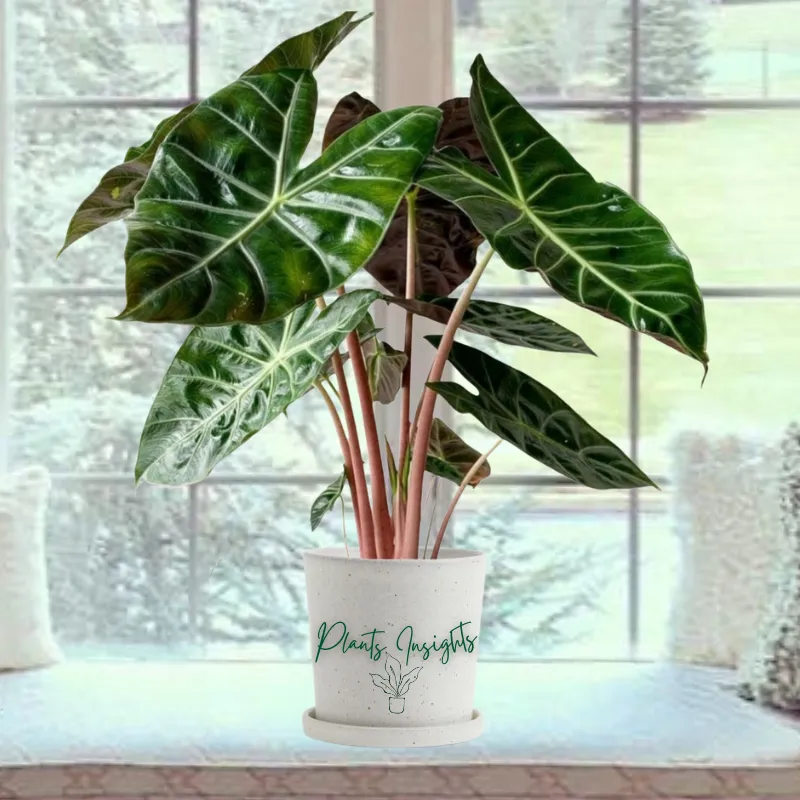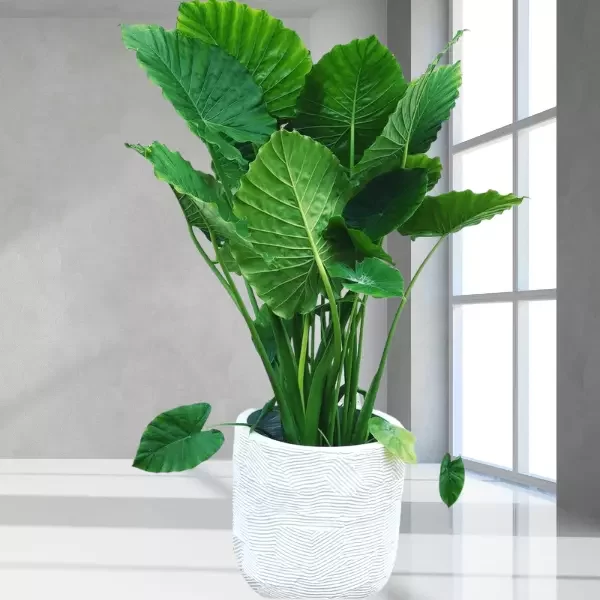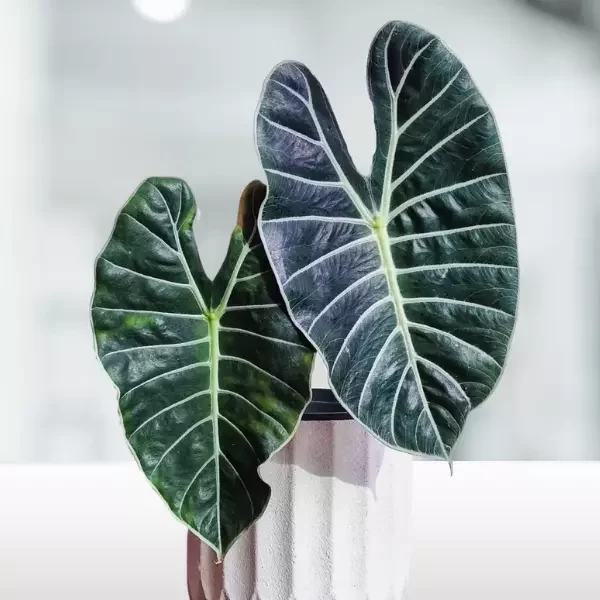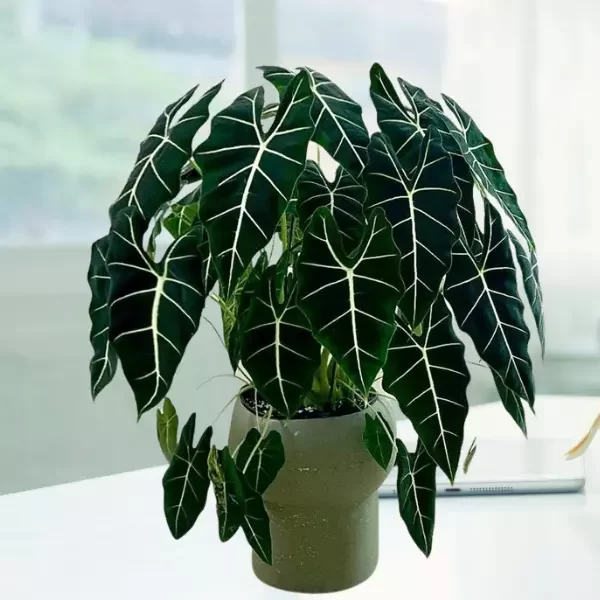The gentle, rhizomatous, evergreen perennial cultivator; Alocasia Pink Dragon belongs to the Araceae family. The plant is famous for its bright pink stems and huge, oblong, light-skinned, green-on-top, and dark purple-on-bottom foliage. Both of these characteristics are attractive to planters. This delicate plant has a leaf that has a very pleasing appearance.
The underparts of the leaves are burgundy, and the stems are a gorgeous shade of pink. This plant’s large leaves and deep veins resemble a Dragon’s scales. The plant is extraordinarily gorgeous, yet it requires very little care and is quite easy to reproduce.
It is uncommon to see a plant with such a distinct appearance yet requiring so little care. It is also popular as the Rose Elephant Dragon or the Elephant Ear Pink Dragon. You can put the plants on bookshelves, empty nooks, or dining tables to display them.
Allied Species: Alocasia Sarian, Alocasia Lauterbachiana, Alocasia Silver Dragon, Alocasia Stingray, Alocasia Portora, Alocasia Cucullata, Alocasia Cuprea, Alocasia Maharani
Related Products:
Habitat & Ecology
| Botanical Name: | Alocasia Aurora |
| Family Name: | Araceae |
| Common names: | Alocasia Pink Dragon, Elephant Ear Pink Dragon |
| Plant type: | Tropical flowering perennial plant |
| Origin: | Native to Philippines |
| Bloom: | Green and pink |
| Height: | 2-3 feet |
| Humidity: | 50%-80%. |
| Temperature: | 60°F-85°F (15 to 26 degrees Celsius) |
| Light Need | Bright, indirect light |
Foliage and Stem
This plant is well-liked by many people due to the exotic beauty of its foliage and expansive spread. The leaves have a slight curvature, a glossy surface, and a dark color. They have a smooth, green surface overall and have venation that is a lighter color everywhere on them.
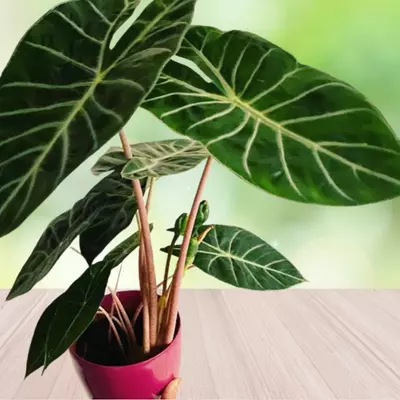
The undersides of the leaves are of gorgeous burgundy color, which grow on petioles that are pink in color. These leaves have the potential to reach a length of fifty centimeters.
Evergreen
The Alocasia Pink Dragon has evergreen foliage, which is fantastic news for people interested in decorative plants. Therefore, the plant will maintain its lovely and sophisticated appearance throughout the year.
In addition to bringing tropics into your living quarters, the plant also functions as an all-natural exhaust system.
Height and width
When grown in ideal conditions, the Alocasia Pink Dragon has the ability to attain a height of 1.2 meters. The plant can grow up to width of 80 centimeters. As a result of these sizes, these cute plants can be exhibited in a variety of different interior settings.
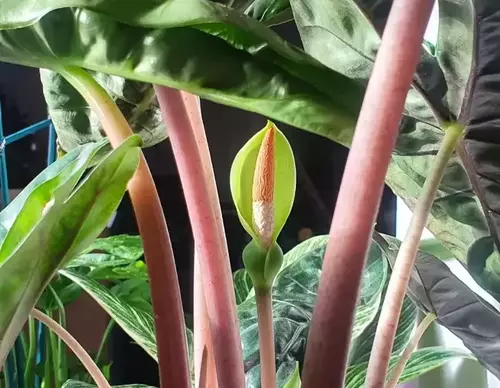
How do you take care of Pink Dragon Alocasia?
Pink Dragon Alocasia is commonly cultivated as an indoor houseplant and thrives in highly humid environments. To protect the plant’s roots from rotting, use a soil mixture that drains well. Furthermore, position it in a room like a bathroom or a kitchen, where there is bright but indirect light. Let us go through in detail the requirements of this gorgeous plant.
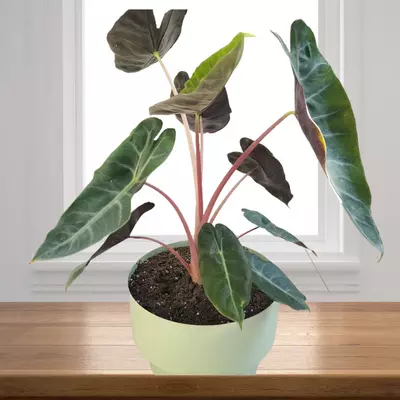

Lighting Requirements
The Alocasia Pink Dragon is a plant native to the tropical regions and loves medium to bright indirect sunlight. Regarding sun exposure, Alocasia Pink Dragon is a tolerant plant. However, it is important to avoid excessive light, as too much direct, bright light will cause leaf scorching and browning.
Bright, indirect lighting is advised for Alocasia Pink Dragon. The leaves are susceptible to sunburn and will develop a drab appearance if exposed to direct sunlight for extended periods of time.
It is preferable to place Alocasia in a well-lit space or beneath fluorescent grow lights. If you wish to position it near a window, west-facing windows would be the most appropriate. Exposure to excessive light will cause the foliage to become crispy and brown in color whereas too many falling leaves indicate that the Pink Dragon requires a sunnier location.
Observe how your plant responds to the light it is receiving, and you will quickly discover the optimal location for it.

Soil Requirements
In order to recreate the natural setting of the Alocasia Pink Dragon as accurately as possible, the soil should be sandy, loose, and permeable. Perlite, Peat moss, and Orchid bark combined into a porous mixture is the ideal medium.
The use of this well-aerated growing medium will encourage the growth of a Pink Dragon and ensure that its roots remain in good health. During the months of spring and summer, when these plants are actively growing, fertilize them on a consistent basis.
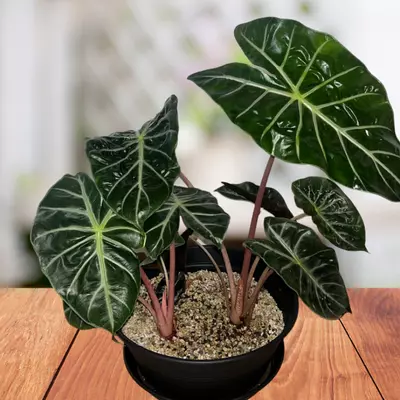
Because the plant is more active and has a greater energy expenditure when the temps are warmer, treating it with nutrients on a consistent basis will encourage plentiful development

Humidity and Temperature
Moisture around the roots and leaves is beneficial to the Pink Dragon Alocasia plant. In order for these plants to attain their full potential, they must be exposed to a higher level of humidity than is typical.
You can accomplish this by increasing the amount of humidity in the air using methods that are artificial and come from the outside. A few examples of these are the utilization of misting sprays, pebble trays, and humidifiers.
The typical temperatures are ideal for the growth of these plants. The entire range would be between 60 and 85 degrees Fahrenheit. They have a genetic inclination for growing in tropical settings, so they do best in environments that are consistently warm.
During the winter, you should move the plant to a location that is less likely to be affected by frost.

Guttation
Guttation is a peculiar condition that can affect Alocasias; it gives the impression that the plant is perspiring because of the appearance of tiny droplets of moisture on the surface of the leaves. This condition is common in Alocasias. It is not necessary to be alarmed by this development; guttation is an entirely normal process that occurs in high-moisture plants like Alocasias.
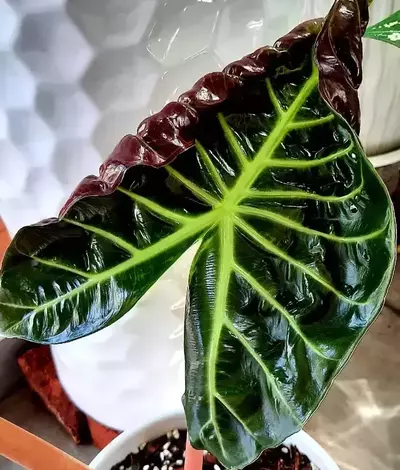
This genus requires a great deal of water, so it eliminates the excess through transpiration when it is not actively using it, such as at night. The Alocasias expel water through stomata which are the tiny holes in the foliage of the plant. It is accomplished by pulling surplus water up from the base of the plant.
The presence of guttation alone does not necessarily indicate that the plant is receiving an excessive amount of water; if the “sweating” appears, there is no need to change anything regarding the care given to the plant. It is simply the plant’s way of maintaining its equilibrium.
If, on the other hand, this symptom appears in conjunction with others, such as the leaves turning yellow or becoming mushy, it may indicate that you need to reduce the amount of water you give the plant.
One of the most important things you can do to keep your Alocasia Pink Dragon plant disease-free, happy, and healthy is to keep a close eye on its condition and how it responds to different environments and types of care.

Fertilizer
You should apply fertilizer to the plant in the spring and summer, when it is most likely to be actively growing. The use of compost is the most effective method for promoting their growth. You can do this by scraping it into the uppermost layer of dirt. This will accomplish the goal. Take care not to damage the roots in any way.

Repotting Alocasia Pink Dragon
Because a Pink Dragon Alocasia will maintain its compact form throughout life, repotting it will not be a demanding task. Every one to two years, depending on the condition of the plant and your good judgment, you should repot it into a larger planter with more room for it to grow.
In addition, please plan to repot the Alocasia Pink Dragon when it has become double in size, and it’s time to move it to a larger container. The new pot should be roughly 1 to 2 inches bigger in diameter and 1 to 2 inches deeper than the old one; if the change is too little, the plant will become pot-bound, and if the shift is too large, the plant will experience shock.
The spring and summer months are when you should be acting on this recommendation. The repotting also brings an opportunity to propagate the plant.

How do you Propagate Alocasia Silver Dragon?
Since Alocasias originate from a central rhizome, propagation from the cuttings is not advisable because they will not produce new roots. Pink Dragon Alocasia is ideally propagated by separating root clumps and then growing them in soil or water.
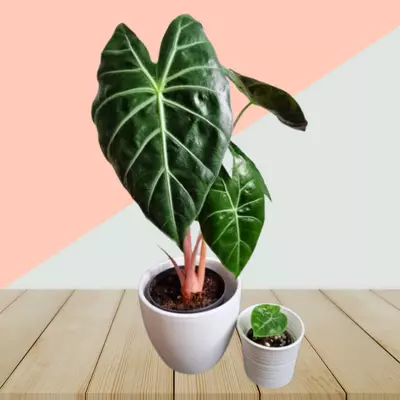
The rhizomes of an Alocasia Pink Dragon can be divided in the spring and summer months in order to facilitate the plant’s propagation and cultivation, respectively.
Propagation in Soil
The methods that are presented below will make it simple for you to comprehend the approach and carry it out correctly.
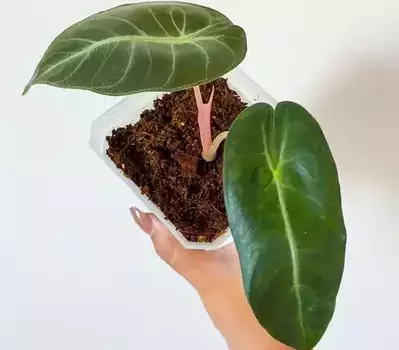
It is important to fertilize the rhizome early in its growth and provide it with consistent amounts of water. Please put them in an environment with the correct proportions of light, temperature, and humidity.
Water Propagation
Alternately, the roots of the split clump can be properly cleansed, and the plant can be placed in a water-filled container. Use a transparent container to observe the root’s growth and immerse the roots completely in water. However, if a leaf becomes submerged, it will perish. Maintain the pond by replenishing the water as needed and avoiding direct sunlight, which may promote algae growth.
These two basic methods of propagation make it easy to multiply a single Pink Dragon into numerous lovely plants.

Cleaning and Pruning
Please form a weekly routine of cleaning the plant to avoid problems with diseases and pests. To thoroughly clean the plant, first, mist it with distilled water or Neem oil, and then wipe it down. Take care to eliminate any pests or dead leaves that may have accumulated in the vicinity of the plant, and check that it seems to be in good health.
Pink Alocasia typically does not require trimming to keep them in check because of their inherently orderly growth pattern. However, to sustain the maximum health of the Rose Elephant Dragon, develop a routine of cutting away dead or yellowing leaves.
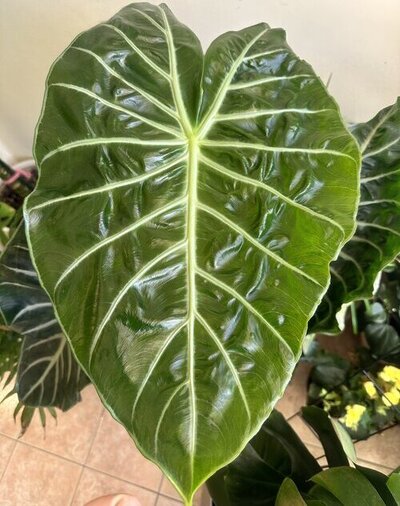
Drought resistance
This plant does not do well in dry environments where there is a lack of water. Therefore, make sure to maintain it adequately hydrated and ensure that it receives the proper amount of irrigation.
Pressure tolerance
Even if stepped on, an Alocasia Pink Dragon will not pass away instantaneously because of its sturdy leaves. On the contrary, consistent external pressure applied in smaller amounts can stunt the overall growth of the plant. Therefore, you should ensure that you set it in an open and spacious space.

Is Alocasia Pink Dragon poisonous?
The Pink Dragon Alocasia is harmful to humans and should never be eaten. If consumed, the plant’s calcium oxalate concentration can result in serious negative effects causing irritation in the mouth and tongue, whereas in worst-case scenarios may result in speech impairment. Therefore, please Keep it away from children and pets.
Pink Dragon Alocasia is poisonous to pets, and you shall take special care to avoid accidental consumption by pets. Please contact the veterinarian immediately if your pet ingests any part of the plant.

Pests, and Diseases
Since Alocasia Pink Dragons are not naturally resistant to pests and diseases, and require special attention for their health and upkeep to avoid problems. The pests like mealybugs, spider mites, scale, thrips, and whitefly usually attack the plant whereas leaf spots, stem wilting and root rot, are typical diseases that affect Alocasia Pink Dragons.
You can avoid these and other issues by maintaining a clean Pink Dragon and never letting dust or moisture settle on or near the plant.
In the event of infection, remove the plant from its environment, apply Neem oil, insecticide, or a rubbing Alcohol solution on foliage and remove any diseased or damaged parts. Also, if you have any further concerns about any lingering pests or diseases, you can try swapping out the soil and washing the container.
Inspecting plants before bringing them home is essential for avoiding these problems, as is maintaining a clean, well-watered environment for your plants.
FAQs
Does Alocasia Pink Dragon go dormant?
Like all other Alocasia plant species, this one enters a dormant period in the winter. During this phase, be careful not to overwater or overfeed the plants, and you should especially refrain from propagation and pruning. Water in large amounts and medium indirect sunlight is necessary for Alocasia Pink Dragon care. In shady interior spaces, temperatures between 60 and 85 °F are ideal. To keep up their lovely structure and shape, fertilize them during the growing season and groom them every week.
Is the Alocasia Pink Dragon an uncommon plant?
It’s true that the Pink Dragon Alocasia is an uncommon form of the Alocasia plant. The most common places to find it are in portions of Australia and South-east Asia.
Why Isn’t My Alocasia Pink Dragon Growing?
There are a few possible explanations for why your Alocasia Pink Dragon isn’t growing as fast as it usually does. It’s possible that the plant isn’t getting enough light or nutrients, that the soil is too dry or that it’s too compact, or that the temperature isn’t quite right. To correct this issue, be sure to provide your Alocasia Pink Dragon with an abundance of strong light and to hydrate it on a regular basis with water that is rich in nutrients. In addition to this, the soil should have some looseness surrounding the plant, and the temperature should be between 68 and 86 degrees Fahrenheit.
Why are The Leaves of Alocasia Pink Dragon are Turning Brown?
The most common causes of browning leaves in the Pink Dragon Alocasia are a lack of humidity or too much direct sunlight.
Related Posts
Alocasia Odora | Elephant Ear Plant Care Tips
Alocasia Odora is a breathtaking beauty and an evergreen perennial that can bring a tremendous look to your gardens and indoors. It is known for its impressive large lush green arrow-shaped leaves and sturdy stem. The distinctive feature of this…
Alocasia Longiloba | Watsoniana, Grandis, Veitchii & Longiloba Siver Care
Hello, fantastic plant parents! We are going to share the care guide of Alocasia Longiloba, another astonishing Aroid. Alocasia Longiloba is a tropical, tuberous flowering plant, another astonishing member of the Araceae family, to give a tropical feel to a…
Alocasia ‘Frydek’ | Green Velvet Alocasia Care Tips
Alocasia Frydek (Alocasia Micholitziana ‘Maxkowskii’) is an astounding and breathtaking member of the Alocasia family that has gained popularity over the last few years due to its flawless soft velvety foliage. This striking plant is known as Green Velvet due…
Alocasia Zebrina | Reticulata,Variegata & Zebrina Tiger Care Guide
Alocasia Zebrina is stunning tropical vegetation and serves as exotic ornamental beauty indoors and outdoors. Unlike other Alocasias, the highlight of the plant is not the foliage but the striking zebra-like striped stems or petioles. Zebrina Alocasia features the iconic…
Alocasia Cucullata | Chinese Taro Care & Propagation Guide
The Araceae family includes many fascinating houseplants, and Alocasia Cucullata is one of them exhibiting radiant, tropical foliage. It is a dazzling and evergreen beauty with a compact growth habit, making it suitable for smaller places to create a harmonious…

